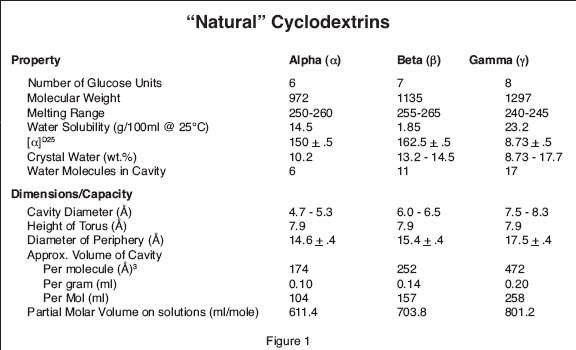
Have you considered improving your medical diagnostic kits with cyclodextrins?
Physico-Chemical InformationTrappsol® is CTD's registered name for its family of Natural Cyclodextrins (Trappsol-Cyclodextrin's) and Chemically Modified Cyclodextrins (Trappsol-CMCyclodextrin's). Trappsol® cyclodextrin derivatives have been introduced by CTD as an expandable line of Cyclodextrin-based aqueous solubilizing and stabilizing agents. Neither the natural Trappsol-Cyclodextrin's nor the currently available Trappsol-CMCyclodextrin's are themselves patentable. Further, it is not likely that other modifications of Trappsol-Cyclodextrin's will be patentable unless unobvious, novel, and useful properties can be demonstrated. The natural Trappsol-Cyclodextrin's Alpha, Beta, and Gamma are cyclic oligosaccharides of respectively 6, 7, and 8 Alpha (1-4) glucopyranose units in the chair conformation. The ring structure resembles a truncated cone. the unusual stability and form of this structure is a result of intramolecular hydrogen bonding between the C2-hydroxyl and C3-hydroxyl of adjacent glucopyranose units. The most energetically stable form of this truncated cone in aqueous solution is with the linking glycosidic and glucopyranose oxygens pointing toward the C6-hydroxyls opposite the hydrogen bonded C2- and C3-hydroxyls. As a result of this unique conformation, the chemical characteristics of the cavity are determined by the electrons contributed by each of the ring forming oxygens. The Trappsol-Cyclodextrin molecule consists of an apolar, electron rich hydrophobic interior and an exterior with sites available for hydrophilic interactions at the entrances to the cavity. In the late 1960's, it was found that the chemical substitution at the 2, 3, and 6 hydroxy groups of the glucopyranose units of the Cyclodextrin ring markedly increased the aqueous solubility of the native Cyclodextrins. Almost all of the Trappsol CMCyclodextrin's studied today have aqueous solubilities of 50g/100ml or greater; compare this to the aqueous solubilities listed for the natural Cyclodextrins. If the chemical substituents themselves are hydrophilic, then one may achieve an even greater aqueous solubility enhancement. Substitution with apolar groups (methyl, ethyl, etc.) allows the list of solubilizing solvents to include many of the common organic solvents. The hydroxypropylated Trappsol-Cyclodextrin's are soluble in water, ethanol, methanol, DMSO, DMF, and some other water miscible solvents. Methylated and Ethylated Trappsol-Cyclodextrin's are soluble in many organic solvents (ether, acetone, chloroform, etc.) while still usually achieving improved aqueous solubility over the parent Cyclodextrins. The nature of the chemical substituents as well as the degree of substitution affect solubility characteristics. Degree of Substitution (DS) is defined as the average number of substituted hydroxyl groups in each Trappsol-Cyclodextrin ring. This number represents an average of the analytical determinations and can theoretically be anything between 0 and 24. With DS there can never be a number smaller than one and non-integer numbers are a result of the averaging computation. Since there are a total of three reactive hydroxyls per glucopyranose unit, the maximum number of substitutents are 18, 21 and 24 respectively for Alpha, Beta, and Gamma Cyclodextrins. One possible explanation for a DS greater than theoretical is linear polymerization. A DS of 11 for HP- Gamma Cyclodextrin means that, on average, each HPG-Cyclodextrin molecule will have eleven HP groups somewhere on the HPG molecule. Another term used to describe substitution frequency is molar substitution (MS). This term describes the substitution frequency in terms of the number of adducts found per glucopyranose unit. In this case a number greater than 3 is not possible; however, numbers smaller than one are possible. In our example above for the HPG with DS=11, the MS is 11/8 or 1.375. Molar substitution is in relation to the number of moles of glucose (glucopyranose unit) in the CD. One explanation for a number greater than the theoretical could be linear polymerization of the chemical adduct. The distribution and size of the adducts are important to complexation since the most reactive primary hydroxyls (C6) are all located around the smaller opening of the Trappsol-Cyclodextrin truncated cone and the less reactive secondary hydroxyls (C2, C3) are all located around the larger opening. DS also affects the aqueous solubility of the Trappsol-CMCyclodextrin. Clearly the nature and number of the chemical adducts will cause the Trappsol-CMCyclodextrin to be more or less water soluble. More water soluble adducts would be expected to make the natural Cyclodextrin more water soluble. The effect of hydrophobic adducts cannot be predicted so readily since the expected improvement in aqueous solubility caused by disturbing the stable hydrogen bonded configuration and exposing sites for additional hydrophilic interactions may be unpredictably affected by the hydrophobicity of the adduct. The practical implication of the Trappsol-CMCyclodextrin's greater aqueous solubility over the natural Trappsol-Cyclodextrin's is that more guest molecules may be accommodated since the relationship between complex formed and host available is usually monotonically increasing. This means that if needed, more active agent may be solubilized quantitatively and reproducibly by using higher concentrations of the Trappsol-CMCyclodextrin. The two figures below will help the reader to visualize chemical structures and calculate molecular weights.
 |
